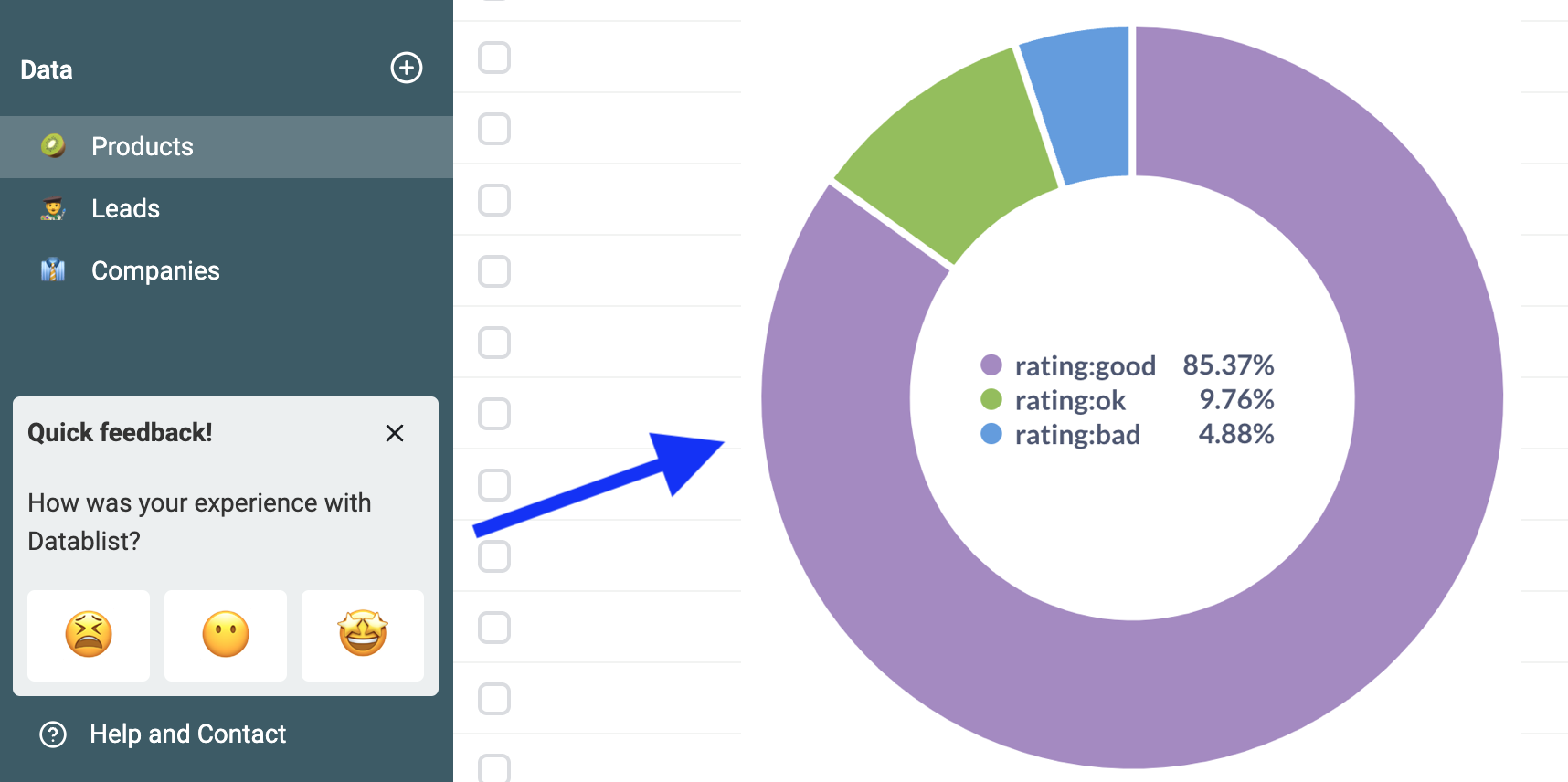Data is everywhere. And I realize it more than ever when I look at the many use cases people have with Datablist.
In 2022, I focused on building the foundations to load and manage data. Here is a summary of Datablist current development and the vision for what's ahead.
Datablist is in freemium. All data management features are accessible for free and you need to upgrade to synchronize your data on the cloud and get credits. With the credits, you access third-party APIs to enrich your data.
Most of my users are free users. On the bright side, the advantage of freemium is to get more usage analytics and feedback to improve the product 😶
Monthly users keep growing and Datablist is used by more than 11k users every month.
Note
You can see an inflection point when I increased the import limit. In January 2022, imports were limited to 10k. Since June 2022 you can import files up to 1.5 million rows (1 million for free users).
The first step in Datablist development was to focus on loading data from external files and simple data management. Datablist has three differentiating features at the moment:
- Datablist handles more than 1.5 million items per collection. You can filter and sort your data on any property. This is higher than any online spreadsheet tool. And way above the limit of Airtable, Coda, and Notion.
- You can consolidate (also called a "join" operation) several listings on a property to build a master list. A basic feature for list management that is not integrated into spreadsheet tools.
- It has a fast and powerful deduplication algorithm. Datablist Duplicates Finder is more powerful than what is available in CRM. Plus it's way faster!
What is Datablist used for?
With those differentiating features, people use Datablist to manage contacts, companies, and product catalogs. Or just to explore their data.
I added a quick online feedback widget few months ago. From the results, users are happy with Datablist 🤩.
Use Case #1: Manage and clean people lists
The top use case is managing user data. It can be an export from Google Contacts, Customers from an e-shop, mailing list subscribers, or company employees.
But also "leads" or candidates for HR recruiters. CRMs are rigid, with processes implemented for sales. Other verticals, for example in the recruitment field, have few alternatives. Most headhunters and recruitment agencies still rely on spreadsheets to structure their searches.
Yet, Datablist is used mostly to manage "leads" or "prospects" for B2B businesses! Leads are sourced from external lists or from their CRM. More and more sales team work with developers to scrape data and generate leads lists. And "lead databases" for any market segment can be built or bought.
They use Datablist to import large amount of data, to deduplicate the leads and to consolidate with external sources or consolidate with data coming from an B2B enrichment services.
👉 After talking with users, I realise the data coming from scraping is always messy. For example data coming from LinkedIn Sales Navigator, or from scraping Facebook need cleaning before being useful. See the next features on cleaning.
Use Case #2: Manage and clean company lists
The second use case is managing lists of companies. This is also for lead generation.
The data comes from scraping webpages, directories, LinkedIn Sales Navigator, APIs, etc.
Or from services such as BuiltWith. For example, if your company targets e-shops, with BuiltWith, you can export all the websites that are built on Shopify, Magento, or Prestashop. From this database, you will clean the data, ignore the websites that are down, and enrich your list with the number of employees, etc.
👉 The "cleaning" and normalization steps are also key here. Fixing bad URLs, removing dead companies, normalizing formats, etc. is a requirement before using the data. See the next features on cleaning.
Use Case #3: Manage product catalog
Datablist is used to manage product catalogs for e-commerce. Shopify and the other e-commerce framework export their data into CSV files. Product catalogs can be used for selling on marketplaces or for marketing (Google Shopping).
The CSV file exported from the e-commerce software is filtered and cleaned with Datablist before being imported elsewhere. Once in Datablist, the catalog can be filtered and exported in a clean "UTF-8" format.
👉 Datablist offers an easy-to-use CSV editor. Some users want to "fix" or process their data before exporting it to a marketplace and Datablist is missing bulk editing features. See the next features for bulk editing
Use Case #4: CSV Editor
And people use Datablist as a CSV editor to explore their data. People import and export their database exports, logs, keyword exports for SEO, etc. This was my first targeted use case when I opened Datablist 💪.
What is next with Datablist 🚀
The top use case is to deal with people and company lists. And people using Datablist to manage leads often have a CRM. They also have Excel or Google Sheets. But yet:
- They don't want to pollute their CRM with hundreds of thousands of cold prospects. Their lead lists come from scrapping, industry exports, or website lists for a specific technology. And they want a tool to manage cold leads. Once a lead shows interest, it is moved into the CRM.
- Microsoft Excel and Google Sheets are built for accounting, not for list management. You can't create data structures, you can't consolidate data sources into a single list, and their deduplication algorithm is basic. But this is their go-to tool for cleaning data.
- Airtable, Notion, and Coda are good for project tracking or building a simple CRM. But you will be limited in the number of leads you can manage. And you won't be able to clean or consolidate data from several CSV files.
I will continue to invest in this lead management use case. Here are some observations of what people expect when managing their lead lists.
First: consolidating lead lists is key
Consolidating and merging lists are key features. This is used for:
-
Aggregate several lead lists into a master collection - You have scraped a list of companies using a specific technology, you also have a list of companies from LinkedIn. Import those lists into a single collection and merge duplicated leads.
-
Refresh leads with updated data - You have imported your mailing list subscribers or your CRM leads. Every month, you need to refresh your data with new exports. Decide which data to keep and which properties to update.
-
Enrich from external services - With SaaS services to validate email addresses and to enrich profiles or companies, you end up playing with several CSV. Consolidate all your CSV into your master lead list in Datablist.
-
Clone your collection, work on it, and merge back your results into the master collection - You don't want to mess with your primary leads list. Clone it, play with the data, clean it, and edit your leads. Then, only if you are happy with the results, pull back the changes into your master collection.
This pattern of merging and consolidating data is missing from spreadsheet tools and other Airtable alternatives. CRMs let you update leads with CSV files using the email address/website URL but you are playing without safety. If you mess it up, your data will be unrecoverable.
👉 Multiple file merging will be improved in Datablist. Updating a lead list using a CSV file with fresh data should be simple. And consolidating data from an email validation service, or an enrichment tool should take only a few steps. See the next features on consolidation.
Second: Bulk editing and cleaning is an integral part of the process
Bulk editing, data cleaning, and normalization are bigger requirements than I expected. This will be a focus on Datablist roadmap.
Datablist has deduplication and merging features but is lacking some basic data management actions such as Find & Replace, bulk editing, etc.
Data cleaning can go very far with normalization and auto-fix of bad data. I'm still brainstorming the features for data cleaning I want to add to Datablist.
👉 I will go step by step on this. Check the roadmap for bulk editing and data cleaning and please share your feedback if you have ideas.
Notes
I don't want to build a tool to clean CRM data. SaaS tools already focus on data cleansing for CRMs. I will first focus on the data that has not yet been poured into a CRM: leads lists build from crawling, scraping, etc. When you have tens of thousands (or hundreds of thousands) of leads. And you want to clean them to find the happy few that match your criteria.
Conclusion
Datablist is here to fill the missing spot between CRM and spreadsheet tools. The road is long, but I'm happy with what I've achieved in 2022.
👉 Check out the next roadmap post. Cleaning and bulk editing features are coming!


